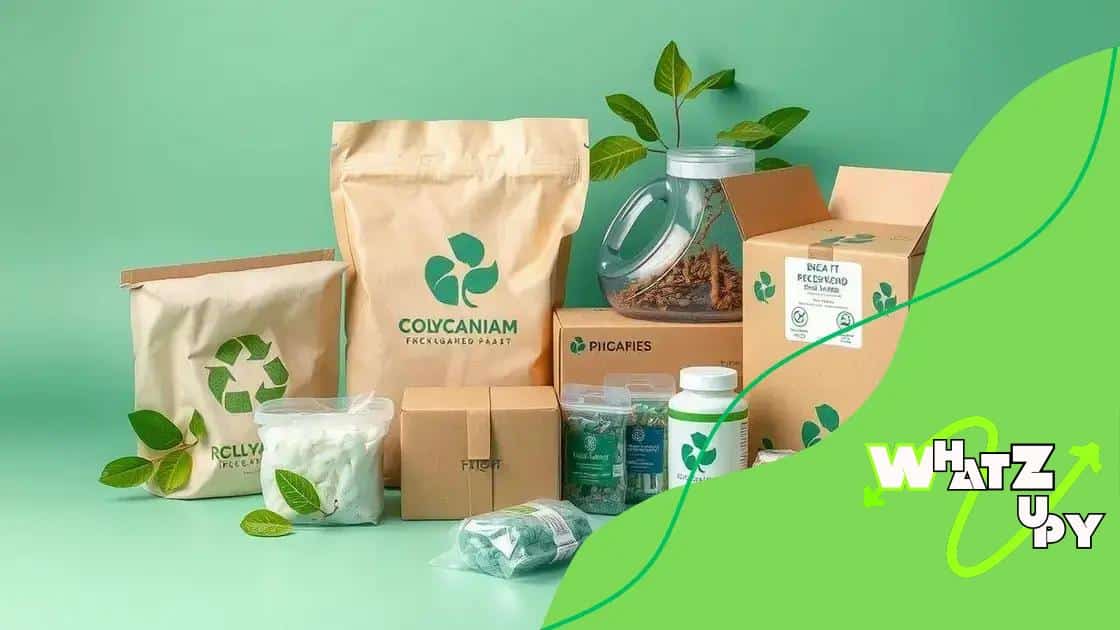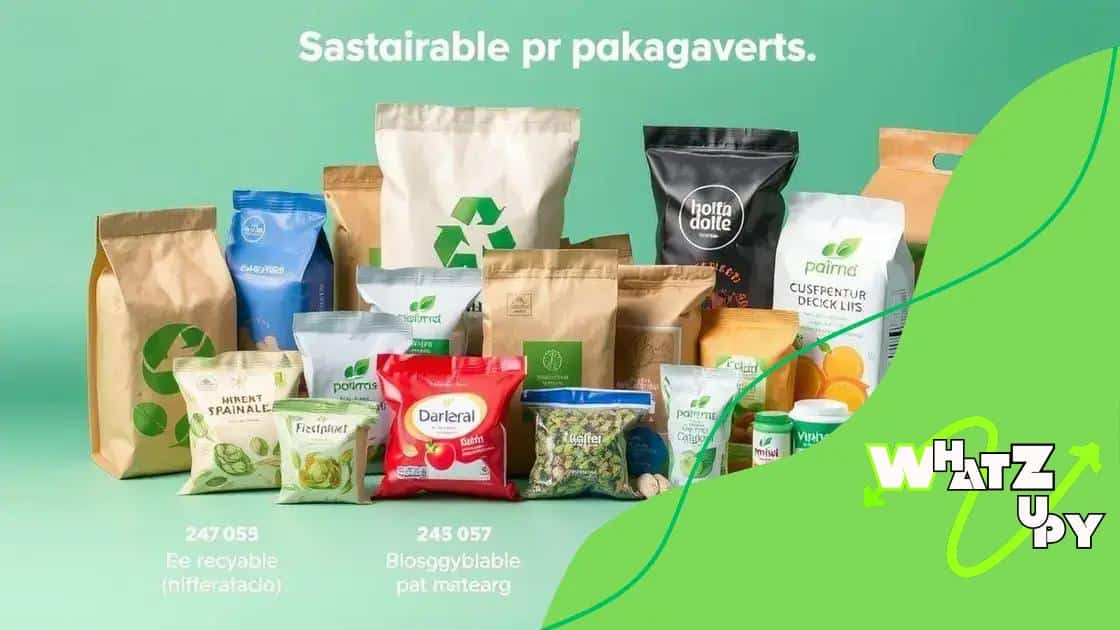Eco-conscious packaging trends driving ecommerce growth

Eco-conscious packaging trends driving ecommerce growth involve the use of sustainable materials, smart technology, and personalized designs, enhancing consumer engagement while reducing environmental impact.
Eco-conscious packaging trends driving ecommerce growth are reshaping the shopping landscape. As more consumers prioritize sustainability, brands are adapting their packaging practices to meet these demands. Curious about how this shift impacts your shopping? Let’s dive in!
Understanding eco-conscious packaging
Understanding eco-conscious packaging is essential in today’s sustainable market. As environmental concerns grow, businesses are changing their packaging strategies to meet consumer demands.
There are several important aspects to consider:
Key Components of Eco-Conscious Packaging
Eco-conscious packaging includes various materials and designs that minimize environmental impact. Brands are increasingly opting for materials that are biodegradable or recyclable.
- Recycled materials: Using packaging made from recycled content helps reduce waste.
- Biodegradable options: Some companies are exploring packaging that decomposes naturally.
- Minimalist design: Reducing material consumption by using less packaging can also benefit the environment.
Transitioning to eco-conscious packaging can also reflect a brand’s commitment to sustainability. Consumers appreciate companies that prioritize environmental responsibility.
Moreover, understanding consumer preferences is key. Many shoppers prefer products that come in sustainable packaging. This preference influences purchasing decisions, as shoppers often choose brands that align with their values.
Benefits of Eco-Conscious Packaging
There are many benefits associated with adopting eco-conscious packaging practices:
- Enhanced brand image: Companies gain a positive reputation by adopting sustainable practices.
- Increased customer loyalty: When consumers see a brand’s commitment to the environment, they are more likely to remain loyal.
- Market differentiation: Eco-friendly practices can set a brand apart from competitors.
By focusing on eco-conscious packaging, businesses can thrive in an evolving market that increasingly values sustainability. As customers recognize these efforts, they are likely to engage more with brands that align with their eco-friendly values.
In summary, understanding eco-conscious packaging is vital for businesses today. Making sustainable choices in packaging can significantly influence consumer behavior, enhancing brand loyalty and standing out in the marketplace.
Key materials driving change
Key materials driving change in eco-conscious packaging are essential for brands looking to adopt sustainable practices. Today, many companies are moving away from traditional packaging materials and exploring alternatives that reduce their environmental impact.
Among the most popular materials are:
Biodegradable Plastics
Biodegradable plastics break down more quickly than conventional plastics. Made from renewable sources, these materials are designed to reduce pollution and landfill waste. Their ability to decompose effectively makes them a great choice for eco-conscious brands.
Recycled Paper and Cardboard
Recycled paper and cardboard are widely used in eco-conscious packaging. They help reduce deforestation while requiring less energy to produce compared to new materials. Many brands are embracing this option to promote sustainability.
- Less environmental impact: Reduces the need for new raw materials.
- Energy-efficient production: Requires less energy than producing new paper.
- Versatile applications: Suitable for various packaging needs.
Additionally, plant-based materials are gaining traction. These materials come from agricultural products, such as cornstarch and sugarcane. They offer an excellent alternative as they are compostable, further supporting the goal of sustainability.
As businesses strive to attract eco-conscious consumers, they must prioritize these materials. The shift towards sustainable packaging is not just a trend; it is becoming a necessity in a market increasingly driven by consumer preferences.
Investing in innovative materials helps brands stand out in a crowded market while showing dedication to environmental stewardship. By understanding the significance of these key materials, companies can better align their packaging with consumer values, driving engagement and loyalty.
Consumer preferences in packaging

Consumer preferences in packaging are crucial for brands aiming to succeed in a sustainable market. Today, shoppers are more aware of their choices, and many prioritize eco-friendly packaging over traditional options. This shift reflects a growing concern for the environment.
Research shows that many consumers actively seek out products that feature sustainable packaging. They appreciate transparency and want to know what materials are used. Key factors influencing their preferences include:
Importance of Sustainability
Many consumers feel a responsibility to the planet. They believe that opting for sustainable options helps reduce waste and promotes a healthier environment. When brands use recyclable or biodegradable materials, they send a positive message about their commitment to sustainability.
Impact on Purchasing Decisions
Purchasing decisions are often influenced by packaging. Consumers are likely to choose brands based on their packaging practices. This trend has led to companies focusing on attractive, sustainable packaging designs to catch the eyes of eco-conscious buyers. Some studies suggest that:
- 75% of consumers prefer brands that use environmentally friendly packaging.
- Innovative designs lead to higher sales among younger customers.
- Brands highlighting their sustainable efforts gain a competitive edge.
Moreover, packaging that is easy to dispose of or recycle enhances the consumer experience. Shoppers are looking for convenience along with sustainability. They often consider how environmentally friendly aspects of the packaging can fit into their daily lives.
Another important factor is the aesthetic appeal of packaging. Many consumers are drawn to visually appealing designs that also convey a message of sustainability. Packaging that showcases creativity and eco-friendliness can create a strong emotional connection with buyers.
Overall, brands that understand consumer preferences in packaging can better align their products with market demands. By focusing on sustainability, convenience, and design, companies can attract more customers while promoting a positive impact on the environment.
Brand strategies for sustainability
Brand strategies for sustainability have become essential as businesses adapt to the changing expectations of consumers. Companies are increasingly focusing on eco-friendly practices that not only meet consumer demands but also enhance their brand image. Developing such strategies is crucial for long-term success.
Some effective approaches include:
Integrating Sustainability into the Supply Chain
By incorporating sustainable practices throughout the supply chain, brands can significantly reduce their environmental footprint. This includes sourcing materials responsibly, minimizing waste, and ensuring ethical labor practices. Sustainability starts at the very beginning of the production process.
Transparent Communication
Transparency is vital in building trust with consumers. Brands that openly share their sustainability efforts and the impact of their practices are more likely to attract eco-conscious customers. Clear labeling and honest marketing can showcase their commitment to sustainability.
- Sharing sustainability goals and progress updates.
- Using certifications to highlight eco-friendly practices.
- Encouraging consumer feedback to improve initiatives.
Another effective strategy is to foster community engagement. Brands that involve their customers in sustainability initiatives create a sense of belonging. Hosting events or campaigns that promote sustainability can deepen connections with consumers.
Moreover, innovative product design plays a significant role in brand strategies for sustainability. Creating products with minimal packaging or using recycled materials can appeal to environmentally aware consumers. Brands must think creatively and prioritize sustainability in their product development process.
Additionally, partnerships with organizations focused on environmental causes can strengthen a brand’s commitment to sustainability. Collaborating with NGOs or joining initiatives can enhance credibility and demonstrate a genuine commitment to making a difference.
Overall, implementing effective brand strategies for sustainability not only meets consumer expectations but also helps build a loyal customer base. Companies committed to eco-friendly practices can gain a competitive advantage in today’s market.
Future trends in ecommerce packaging
Future trends in ecommerce packaging focus on innovations that enhance sustainability and improve the consumer experience. As online shopping continues to grow, brands are urged to adapt their packaging strategies to meet changing consumer demands.
One emerging trend is the use of smart packaging. This technology enables brands to interact with consumers through integrated QR codes or NFC chips. Customers can scan these codes to access product information, recycling tips, or promotional content. This interactive approach enhances the shopping experience while promoting sustainability.
Customization and Personalization
Another significant trend is the demand for customized packaging solutions. Consumers increasingly seek options that reflect their preferences. Brands can respond by offering personalized boxes or sustainable packaging designs that cater to individual tastes, thus creating a unique unboxing experience.
Sustainable Materials
There is a growing expectation for the use of sustainable materials in packaging. As awareness of environmental issues rises, brands must adopt renewable, biodegradable, or recyclable materials in their packaging. Trends indicate that consumers will continue to favor companies making eco-friendly choices.
- Biodegradable plastics are gaining popularity for their ability to decompose naturally.
- Recycled materials reduce the need for new resources, supporting a circular economy.
- Switching to plant-based materials will also be important as industries innovate.
Moreover, minimalistic packaging design is becoming highly favored. Consumers appreciate less waste, so brands are creating simple, functional packaging that reduces material use. This trend aligns with the desire for sustainability and convenience.
As ecommerce continues to evolve, companies must stay ahead by embracing these trends. Adopting smart technologies, sustainable materials, and personalized designs will not only attract customers but also contribute to a healthier planet.
FAQ – Frequently Asked Questions about Eco-Conscious Packaging Trends in Ecommerce
What is eco-conscious packaging?
Eco-conscious packaging refers to materials and designs that minimize environmental impact, often using renewable, recyclable, or biodegradable sources.
Why is personalization in packaging important?
Personalization enhances the customer experience, making products feel unique and tailored, which can increase customer loyalty and satisfaction.
How can smart packaging benefit brands?
Smart packaging incorporates technology, allowing brands to provide interactive experiences, share important product information, and engage consumers directly.
What materials are considered sustainable for ecommerce packaging?
Sustainable materials include biodegradable plastics, recycled paper, and plant-based options that reduce waste and environmental impact.





